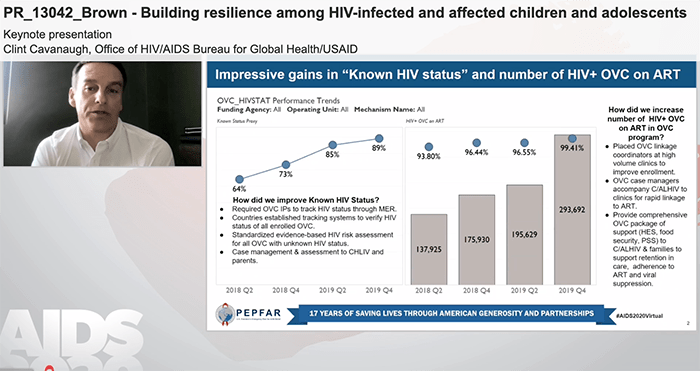Blog
AIDS 2020: Evidence-based approaches for reaching HIV epidemic control among children and adolescents

Community and clinical service providers working together to meet the needs of children and adolescents living with HIV. Digging deep into data to identify those at high risk and how best to reach them. Strong community platforms and wrap-around services. These are among the tools that international and local partners should embrace to achieve epidemic control among children and adolescents living with HIV, a crucial group in the fight to end AIDS, according to panelists who shared their expertise during an opening day satellite session of the 23rd International AIDS Conference.
AIDS 2020, which is virtual this year, is taking place July 6-10. With the Office of the Global AIDS Coordinator, USAID’s Office of HIV/AIDS, and Jhpiego, Pact hosted a discussion on building resilience among HIV-infected and affected children and adolescents. The panel focused on the latest information, specific actions and evidence-based approaches for reaching epidemic control among children and adolescents living with HIV, including priorities for expanding HIV treatment for children and adolescents, and data-driven interventions and lessons learned for leveraging orphans and vulnerable children (OVC) programs to improve pediatric case finding, antiretroviral therapy (ART) initiation and retention, and viral load suppression. Hilary Wolf, senior technical advisor for pediatric care and treatment at the Office of the Global AIDS Coordinator, served as moderator.
Pact’s president and CEO, Caroline Anstey, opened the session by noting that while the global community has made tremendous progress in combatting HIV over the past three decades, efforts to reach children and adolescents have lagged behind.
“According to UNAIDS, globally, there are 1.7 million children under 15 living with HIV. Of these, only 54% have access to treatment,” Anstey said. She noted that new modeling from UNAIDS has shown that the ongoing Covid-19 pandemic could make it even more difficult for children to access HIV care and treatment.
Anstey said the roadmap to epidemic control requires us to focus on youth and their families.
Keynote speaker Clint Cavanaugh, director of the Office of HIV/AIDS for USAID’s Global Health Bureau, said the agency has prioritized children and adolescents living with HIV through its OVC programming. PEPFAR and USAID have made marked progress in recent years in increasing the number of children and adolescents in OVC programs who know their HIV status, as well as the number who are on ART, Cavanaugh said, mainly by adapting an HIV risk assessment tool used in outpatient settings to one that is now widely used in community settings by OVC frontline staff. Strong clinical partnerships, case management and wrap-around services including food security assistance and household economic strengthening help build an environment where adherence and viral suppression are achievable, he said.
“Despite these gains, we still have a lot of work to do to reach 95-95-95 for children and adolescents living with HIV,” Cavanaugh said. He noted that compared with adults, children and adolescents are significantly less likely to know their HIV status, to be linked and adherent to ART and to achieve viral suppression.
Continuing to improve the reach and effectiveness of OVC programming is key to overcoming the disparity, Cavanaugh said. He said USAID is working to expand and standardize viral load monitoring, to overcome high rates of parents declining HIV testing for their children, to leverage multi-month medication dispensing and to continue adapting its OVC programming in light of Covid-19.
“We are encouraged by what OVC programs have been able to do amid the very challenging circumstances of Covid, especially when half or more of beneficiaries don’t have access to cell phones,” Cavanaugh said. “The gold standard is to achieve viral suppression for children and adolescents living with HIV enrolled in OVC programs. USAID has developed an OVC clinical strategy to operationalize guidance across the cascade so that viral load coverage and suppression improve for children and adolescents and their families.”

Panelists from two Pact-led USAID OVC projects – Asheri Barankena from Kizazi Kipya and Silvia Kelbert from ACHIEVE – shared programmatic examples from Tanzania and South Sudan, including challenges, opportunities and lessons learned in reaching children and adolescents living with HIV through community-based OVC platforms. Barankena noted that country OVC and facility-based programs should work together, sharing data, to improve targeted case finding and treatment support for children and adolescents. Kelbert said treatment literacy is a powerful tool, especially for children, who have their whole lives ahead of them. Both Barankena and Kelbert highlighted data showing accelerated progress in closing the 95-95-95 gaps among children and adolescents living with HIV enrolled in OVC programs who benefit from comprehensive, family-based case management support and ongoing linkages to clinical services.
Gloria Sangiwa, Pact’s vice president for Integrated Program Advancement, closed the session. “Even with the focus on improving clinical treatment outcomes, strong community platforms and non-clinical wrap-around services are needed more than ever. Let’s not forget the basic issues of food security, economic strengthening, psychosocial support and positive parenting. An enabling environment, especially in the household, is important to enable adherence and retention in treatment among children and adolescents living with HIV,” Sangiwa said.
“I would like to challenge all of us to think of ways to use these lessons and this conference to meet our goal of an AIDS-free generation everywhere by 2030.”
Portions of this presentation are available to AIDS 2020 participants through the conference’s on-demand satellite sessions channel.
Learn more about Pact’s HIV and AIDS work at pactworld.org/hiv-aids.